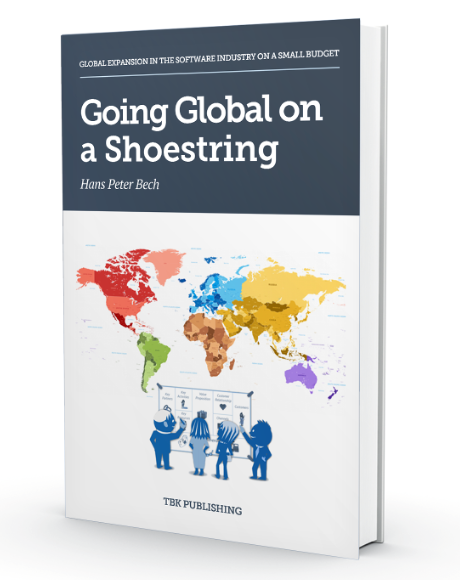Going Global on a Shoestring
How do you go global on a shoestring when borders close, airlines stop operating, global supply chains break down, the economy falls like a stone, and you need to wear a face mask when going out?

I am delighted to announce that my book Going Global on a Shoestring will be available on September 1st, 2020 in print and for Kindle. You can preorder for Kindle now. Add your email to this list and I will notify you when the print version becomes available for preorder. The audio version will be available later.
I have written the book to help small B2B software companies (with a staff of between 20 and 200 people – approximately) find ways to adjust and make their business model work in foreign markets. Because entering foreign markets is the path to long term prosperity.
And then we got Covid-19
By March 2020, I was well underway with the manuscript when a pandemic suddenly hit us. We have had pandemics before, but a comparable one, such as the Spanish Flu, was more than a hundred years ago. The Swine Flu that started in North America in 2009 didn’t seem to be the benchmark.
How do you go global on a shoestring when borders close, airlines stop operating, global supply chains break down, the economy falls like a stone, and you need to wear a face mask when going out?
Indeed, some activities have temporarily been rendered impossible, but others have changed for the better. In the chapter describing the virtual business scenario, I explain how the Covid-19 pandemic has moved the thresholds in your favour. Suddenly you can accomplish much more without meeting people in person. Some of these thresholds have moved permanently, while others will swing back when we have the virus behind us.
The recession caused by Covid-19 will not last forever and it will not fundamentally change how we do business in the software industry, but it may have an impact here and there. I do refer to Covid-19 now and then, but this is not a book about how to overcome or take advantage of a pandemic. A book on that subject would certainly be relevant, but it would be short-lived. It would also be hard to write because the Covid-19 pandemic affects businesses very differently.
Small is beautiful
I come from Denmark. We are a small country with a little over five million people. We speak Danish, but most of us speak reasonable English also, and some of us even speak three or more foreign languages such as German, French or Spanish.
Denmark represents less than 0.5 per cent of global demand for anything. This is probably the reason why most Danish software companies enter foreign markets very early in their lifecycle and at stages where most of them only have limited investment capabilities. They get attracted by the promise of the 99.5 per cent of the global market that is elsewhere, they can get a long way with English, German, French and Spanish as their second or third language, but need to find inexpensive hacks to win customers and business partners.
They want and need to go global on a shoestring.

A great example is the products behind Microsoft’s Dynamics 365, where the ERP components originate from the Danish company Navision. You can find the details of how that happened in my book, 5,460 Miles from Silicon Valley – The In-depth Case Study of What Became Microsoft’s First Billion Dollar Acquisition Outside the USA.
While getting access to international markets is extremely attractive and will multiply the value of any software company that succeeds, this is probably also the most difficult step you can take. As difficult as getting the business started in the first place. Especially if you are on a tight budget.
In the book, I share my experience and what I believe are fundamental principles that can be used by any small software company that has a great product, but only limited funds. My ambition has been to make this the handbook for how to enter foreign markets without betting the farm and failing fatally on the first attempt.
Calling it a handbook doesn’t imply that there is a single and linear approach that will lead to success for anyone anywhere. Such an approach doesn’t exist. Instead, it implies that you will find practical examples and down to earth discussions relevant to the subject. You can take away and try out those ideas that you find applicable to your business case.
It is on purpose that I mainly use case stories from companies that you probably don’t know. Because no one knows you either. That’s the main characteristic of your challenge. How to get business in a new market when you are a complete unknown and only have limited resources available.








